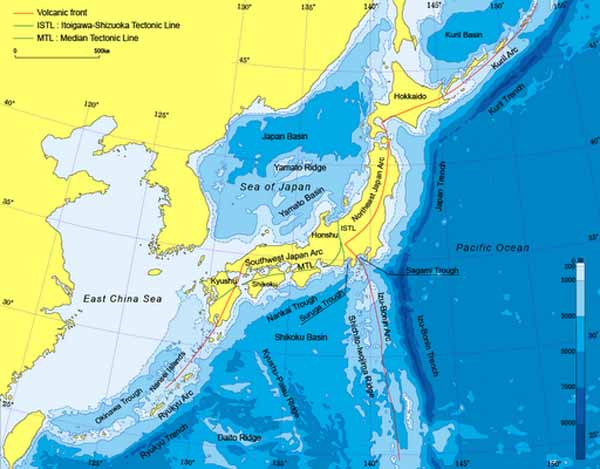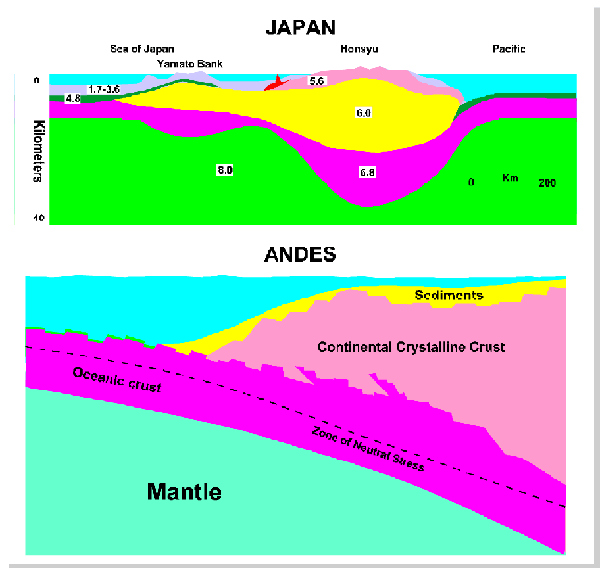
An island arc is a curving series of volcanic islands which alignment is arc-shaped, and which are situated parallel and close to a boundary between two converging tectonic plates.
According to prevailing theory, island arcs are formed where two lithospheric plates (enormous rigid slabs that constitute segments of the Earth’s surface) converge. Upon colliding, one of the plates—that bearing heavy, oceanic crust—buckles downward and is forced into the partially molten lower mantle beneath the second plate with lighter, continental crust. An island arc is built up from the surface of the overriding plate by the extrusion of basalts and andesites. The basalts are thought to be derived from the semimolten mantle, whereas the andesites are probably generated by the partial melting of the descending plate and the sediments that have accumulated on its surface.
These magmas then rise through fractures and melt their way through the overlying crust to be extruded in the form of volcanoes. The volcanoes are generally andesitic in composition. If the overriding plate is oceanic, then volcanoes are extruded underwater and may eventually rise high enough to become islands. The volcanoes form in a line because the angle and rate of subduction, and hence the distance to the depth where melting occurs is consistent. Because the surface of Earth is curved, the line of volcanoes forms in an arcuate pattern in much the same manner as an arc is produced when a planar surface intersects a sphere.
The Aleutian Islands, the islands of Japan, and the Lesser Antilles are all examples of island arcs.
Most island arcs consist of two parallel, arcuate rows of islands. The inner row of such a double arc is composed of a string of explosive volcanoes, while the outer row is made up of nonvolcanic islands. In the case of single arcs, many of the constituent islands are volcanically active.

The term volcanic arc is often interchanged with island arc, although volcanic arc can also refer to land-based volcanoes produced by subduction. Large parts of the Andes/Central American/Canadian mountain chain is the result of a continental volcanic arc.
However, this is only true for those island arcs that are part of the group of mountain belts which are called volcanic arcs, a term which is used when all the elements of the arc-shaped mountain belt are composed of volcanoes, but they are not islands (being situated upon and along a continental area) and are thus not classified as an island arc.
The Aegean or Hellenic arc in the Mediterranean Area, composed of numerous islands such as Crete, is an island arc, but is not volcanic. Parallel to it is the South Aegean Volcanic Arc, which is the volcanic island arc of the same tectonic system.
The volcanoes are generally andesitic in composition. If the overriding plate is oceanic, then volcanoes are extruded underwater and may eventually rise high enough to become islands. The volcanoes form in a line because the angle and rate of subduction, and hence the distance to the depth where melting occurs is consistent. Because the surface of Earth is curved, the line of volcanoes forms in an arcuate pattern in much the same manner as an arc is produced when a planar surface intersects a sphere.
Island arcs are usually accompanied by rapid erosion and sedimentation into accompanying basins. A back-arc basin occurs on the side of the overriding plate and a fore-arc basin forms toward the subducted plate side. Typically, a deep oceanic trench, such as the Marianas Trench, bounds an island arc on the oceanic side beyond the fore-arc basin.
An island arc typically has a land mass or a partially enclosed, unusually shallow sea on its concave side. Along the convex side there almost invariably exists a long, narrow deep-sea trench. The greatest ocean depths are found in these depressions of the seafloor, as in the case of the Mariana and Tonga trenches.
Destructive earthquakes occur frequently at the site of island arcs. Unlike the shallow earthquakes that are recorded in other areas of the world, these are deep-focus seismic events emanating from as much as 370 miles (600 km) below the base of an arc. The quakes tend to have foci of progressively greater depth toward the arc’s concave side.
The majority of island arcs occur along the western margin of the Pacific Basin. The few exceptions are the East Indian and the West Indian arcs and the Scotia Arc in the South Atlantic.

